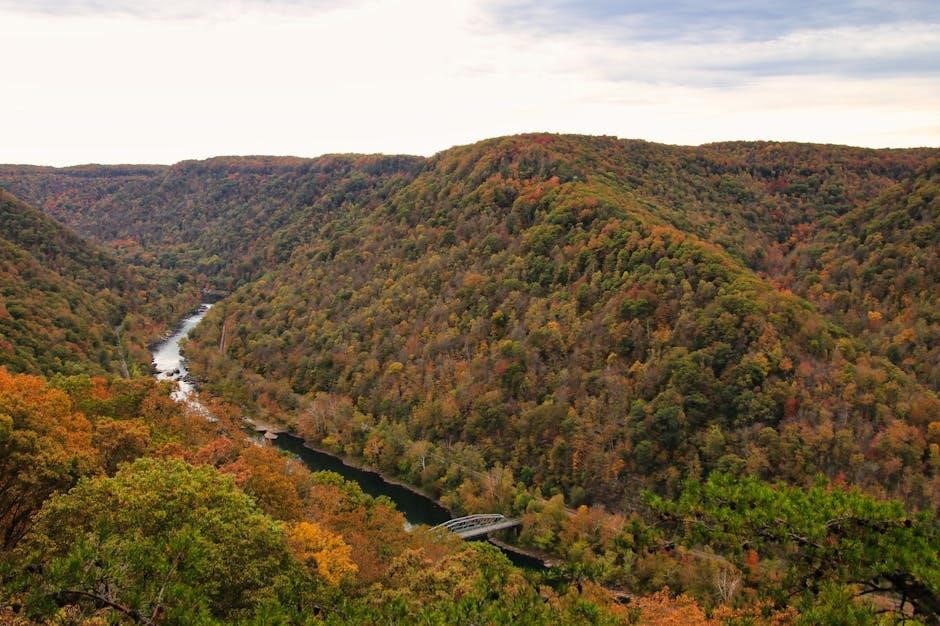
canyon guide
Canyons are breathtaking natural wonders, carved by rivers over millions of years, showcasing stunning geological formations and biodiversity. They offer insights into Earth’s history and support unique ecosystems, attracting explorers and scientists alike.
Definition and Formation of Canyons
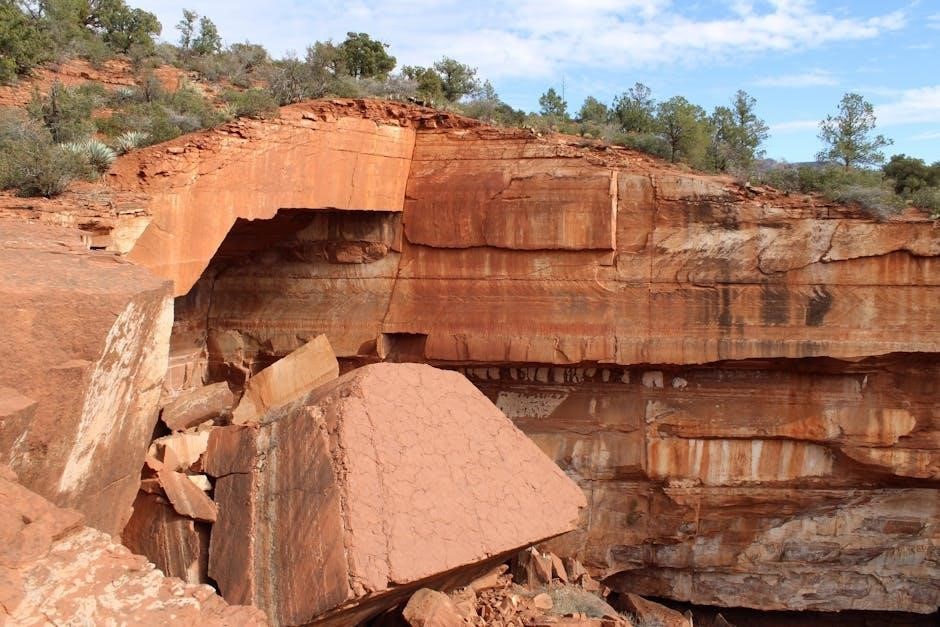
Canyons are deep, narrow valleys carved by rivers over millions of years. Their formation begins with a river cutting into rock, gradually deepening and widening the valley. Erosion, weathering, and tectonic activity shape these natural wonders. The process is slow, with rivers persistently flowing and carving through layers of rock. Over time, the canyon expands, revealing geological history in its exposed strata. Factors like rock type and climate influence their depth and shape. Iconic examples like the Grand Canyon showcase this process, offering a visual timeline of Earth’s history through their layered walls.
Importance of Canyons in Geography and Ecology
Canyons are vital natural wonders, playing a crucial role in geography and ecology. They provide insights into Earth’s geological history, revealing layers of rock that tell stories of ancient landscapes. Ecologically, canyons support unique biodiversity, hosting flora and fauna adapted to harsh, isolated environments. Rivers carving these landscapes sustain ecosystems, supplying water to surrounding regions. Canyons also act as natural barriers and corridors, influencing local climates and wildlife migration patterns. Their deep valleys often harbor rare species, making them critical for conservation efforts. Additionally, canyons contribute to scientific research and education, offering opportunities to study geological processes and ecological adaptations.
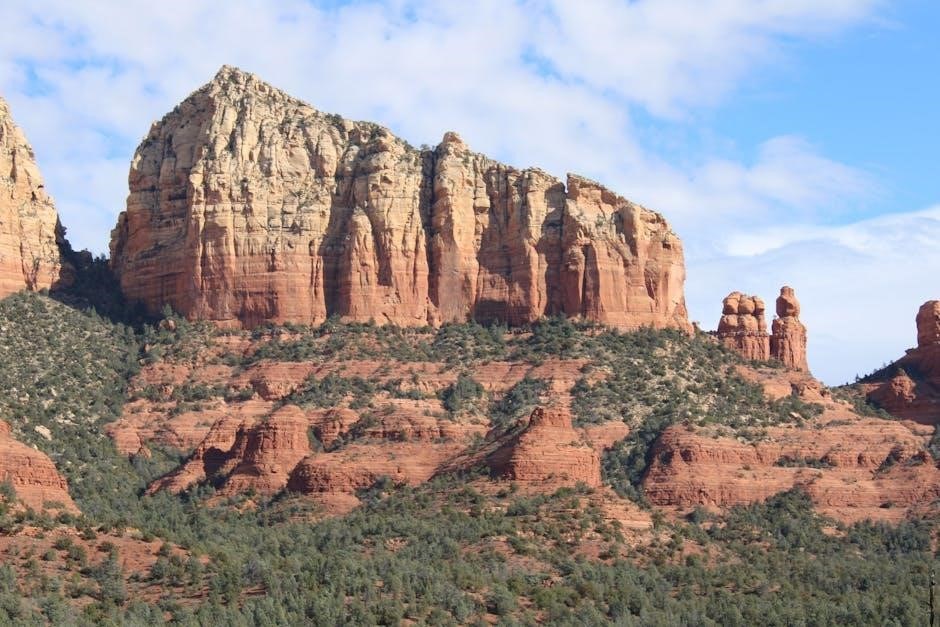
Popular Canyons Around the World
Explore iconic canyons like the Grand Canyon, Bryce Canyon, and Antelope Canyon in the USA, Fish River Canyon in Namibia, Colca Canyon in Peru, Verdon Gorge in France, Taroko Gorge in Taiwan, and Kali Gandaki Gorge in Nepal, each offering unique landscapes and breathtaking views.
Grand Canyon (USA)
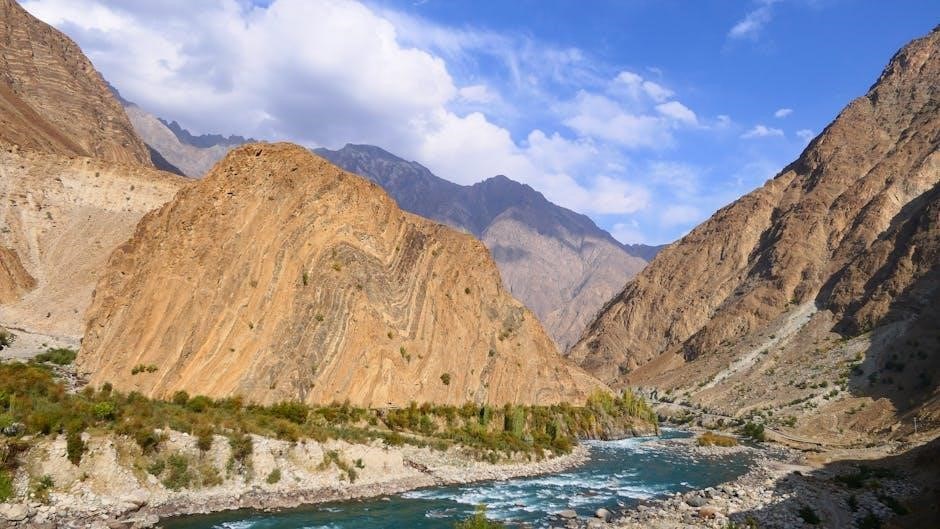
The Grand Canyon, located in Arizona, is one of the most iconic natural wonders in the United States. Carved by the Colorado River over millions of years, it stretches 277 miles long, up to 18 miles wide, and a mile deep. Known for its dramatic layers of rock, the canyon reveals Earth’s geological history. As part of Utah’s Mighty 5, it often gets overshadowed by Zion National Park, but its sheer scale and biodiversity make it a must-visit destination. Hiking, camping, and scenic drives offer unforgettable experiences, showcasing its vast landscapes and ecological significance.
Bryce Canyon (USA)
Bryce Canyon, part of Utah’s Mighty 5, is a unique national park known for its distinctive hoodoos—tall, thin rock formations created by erosion. Often overshadowed by its neighbor Zion National Park, Bryce offers a natural amphitheater of red, orange, and white rocks. The canyon’s scenic vistas and hiking trails attract visitors worldwide. Its unique geological features and vibrant colors make it a must-visit for nature enthusiasts and photographers. The park’s elevation provides a cooler climate, making it ideal for summer visits and winter sports like cross-country skiing.
Antelope Canyon (USA)
Antelope Canyon, located on Navajo land in Arizona, is a iconic natural wonder renowned for its surreal, wave-like rock formations. Its two main sections, Upper and Lower Antelope Canyon, attract photographers and adventurers worldwide. The canyon’s unique shapes, created by millions of years of erosion, offer breathtaking vistas. Guided tours are essential due to sensitive cultural and environmental factors. The nearby Marble Canyon Lodge recently reopened, enhancing visitor access. Antelope Canyon’s stunning beauty and geological significance make it a must-visit destination for those exploring the American Southwest’s natural marvels.
Fish River Canyon (Namibia)
Fish River Canyon, located in southern Namibia, is one of Africa’s most spectacular natural wonders. It is the continent’s largest canyon, stretching over 160 kilometers in length and reaching depths of up to 550 meters. Carved by the Fish River over millions of years, the canyon features dramatic landscapes, rugged cliffs, and vast, arid plains. Visitors can explore the canyon through hiking trails, such as the famous 5-day Fish River Hiking Trail, which offers breathtaking views and immersive experiences. The canyon’s unique ecosystem supports a variety of flora and fauna adapted to its harsh, dry conditions, making it a fascinating destination for nature enthusiasts and adventurers alike.
Colca Canyon (Peru)
Colca Canyon, one of the deepest canyons in the world, is a stunning natural wonder in southern Peru. Twice as deep as the Grand Canyon, it offers breathtaking views and diverse wildlife. The canyon is home to the iconic Andean condor, often seen soaring overhead. Visitors can explore traditional Andean villages, hot springs, and ancient Inca terraces. The canyon’s rugged landscape and rich cultural heritage make it a must-visit destination for adventurers and nature enthusiasts. Its remote location adds to its allure, providing an immersive experience into Peru’s natural and cultural treasures.
Verdon Gorge (France)
Verdon Gorge, located in southeastern France, is one of Europe’s most spectacular canyons. Known as the “Grand Canyon of Europe,” it is renowned for its turquoise waters and limestone cliffs. The Verdon River carves through the landscape, creating a 25-kilometer-long gorge with depths reaching 300 meters. Popular among hikers, rafters, and paragliders, Verdon Gorge offers breathtaking views and thrilling adventures. Its crystal-clear waters and vibrant flora make it a must-visit destination. Recent updates on platforms like Mapy.cz highlight its growing popularity, with improved imagery and trail maps now available for explorers planning their visits.
Taroko Gorge (Taiwan)
Taroko Gorge, located in eastern Taiwan, is one of Asia’s most spectacular canyons, known for its marble-walled cliffs and lush vegetation. Part of Taroko National Park, it features the iconic Marble Grotto, hiking trails like the Baolu Trail, and the Shakadang River. The gorge is a testament to Taiwan’s geological diversity, with its deep valleys and waterfalls attracting adventurers and nature enthusiasts. Visitors can explore tunnels, hot springs, and aboriginal villages, experiencing the rich cultural and natural heritage of the region. Taroko Gorge is a must-visit for those seeking breathtaking landscapes and immersive outdoor experiences.
Kali Gandaki Gorge (Nepal)
The Kali Gandaki Gorge, located in Nepal, is one of the deepest canyons in the world, carved by the Kali Gandaki River. It lies between the Annapurna and Dhaulagiri mountain ranges, creating a dramatic landscape. The gorge is not only a geological marvel but also holds cultural significance, with ancient fossils and religious sites like the Muktinath Temple nearby. Trekkers often explore this region, drawn by its stunning vistas and spiritual importance. The gorge’s unique biodiversity and rugged terrain make it a fascinating destination for adventurers and nature enthusiasts alike.
Planning Your Canyon Visit
Planning a canyon visit requires research and preparation. Determine the best season, book guided tours in advance, and pack essentials like maps, water, and sturdy footwear.
Check weather forecasts and trail conditions to ensure a safe and enjoyable experience.
Best Time to Visit Canyons
The ideal time to visit canyons varies by location and climate. Spring (March to May) and fall (September to November) offer mild temperatures, making them perfect for hiking and exploration. Summer months can be hot, especially in desert canyons like the Grand Canyon, but are great for water activities like rafting. Winter brings serene landscapes, though some trails may be inaccessible due to snow. Check local weather forecasts and plan accordingly, as extreme conditions like flash floods or heatwaves can impact visits. Timing your trip during shoulder seasons often means fewer crowds and more immersive experiences.
Essential Gear for Canyon Exploration
Exploring canyons requires careful preparation with the right gear. Sturdy hiking boots, water, and a map are essentials. A first-aid kit, headlamp, and extra layers are crucial for safety. Sunscreen, a hat, and sunglasses protect against harsh conditions. Trekking poles can aid navigation on uneven terrain. Carry a lightweight emergency shelter and a multi-tool for unexpected situations. Ensure your phone is fully charged, and consider a portable charger. Proper gear ensures a safe and enjoyable canyon adventure, allowing you to focus on the breathtaking landscapes and unique ecosystems these natural wonders offer.
Hiring a Guide or Joining a Tour
Hiring a guide or joining a tour is an excellent way to explore canyons safely and knowledgeably. Guides provide expert insights into the geological history, unique flora, and fauna of the area. Many tours, like those in Bryce Canyon, offer structured itineraries, ensuring you maximize your experience. They often include safety briefings, equipment, and navigation assistance, which are especially crucial for inexperienced explorers. Additionally, guided tours help minimize environmental impact by promoting responsible tourism. Look for reputable companies with experienced guides to ensure a memorable and safe adventure. This approach also supports local economies and conservation efforts in many canyon regions.
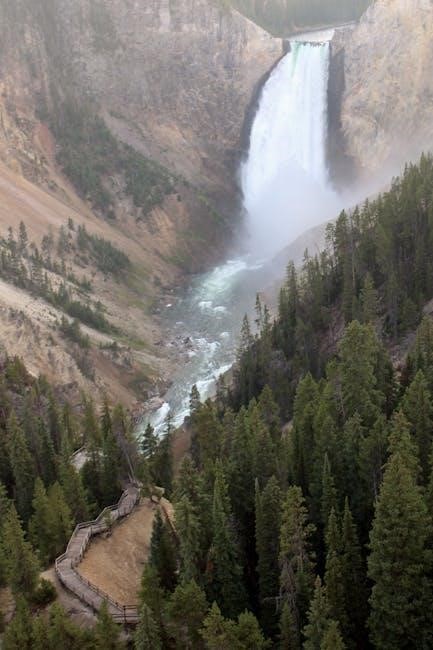
Navigation Tools and Maps
Navigation is crucial for canyon exploration, requiring reliable tools and detailed maps. GPS devices, compasses, and topographic maps are essentials, helping explorers track their routes and locate landmarks. Online platforms like Mapy.cz offer route planning and saved points, aiding hikers in navigating complex terrains. Combining digital tools with traditional navigation methods ensures safety and accuracy. Always download maps in advance, as canyon areas often have limited internet access. Proper navigation preparation prevents disorientation and enhances the overall canyon experience, allowing adventurers to focus on enjoying nature’s grandeur while staying on course.
Safety Tips for Canyon Exploration
Always check weather forecasts, stay hydrated, and use proper gear. Plan routes, carry emergency supplies, and inform others of your itinerary to ensure a safe canyon experience.
Preparing for Emergencies
When exploring canyons, it’s crucial to be prepared for emergencies. Always carry a first-aid kit, a map, and a headlamp. Check weather forecasts to avoid sudden storms. Inform someone about your itinerary and expected return time. Stay on designated trails to minimize risks. Bring a portable charger for your phone and consider a satellite communication device. Pack extra water, snacks, and a multi-tool. Familiarize yourself with basic first aid and know the nearest emergency services. Carry an emergency shelter and warmth sources, especially in colder regions. Being proactive ensures a safer and more enjoyable canyon experience.
Understanding Weather Risks
Weather conditions in canyons can be unpredictable and pose significant risks. Flash floods, triggered by sudden rainstorms, are a major hazard, especially in narrow canyon passages. Rockfalls and landslides may occur due to heavy rainfall or thunderstorms. Extreme heat during summer months can lead to dehydration, while cold snaps in winter may create icy trails. Monitoring local weather forecasts is essential before and during visits. Understanding microclimates unique to canyon environments helps prepare for potential dangers. Always check for weather alerts and be ready to adapt plans if conditions deteriorate. Staying informed ensures a safer and more enjoyable canyon experience.
Staying on Designated Trails
Staying on designated trails is crucial for both safety and environmental preservation. Venturing off paths can damage fragile ecosystems and increase the risk of accidents. Trails are carefully marked to guide visitors through safe routes, avoiding hazardous areas like steep drop-offs or unstable terrain. Using tools like GPS and maps, such as those provided by services like Mapy.cz, helps navigate effectively. By staying on trails, visitors contribute to responsible tourism, protecting both themselves and the canyon’s natural beauty for future explorers. This practice also supports conservation efforts, ensuring these unique landscapes remain intact for generations to come.
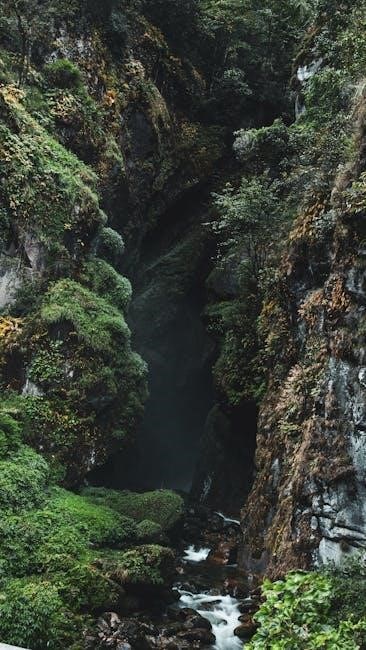
Photography in Canyons
Photography in canyons captures their grandeur and beauty. The golden hours offer ideal lighting, while unique rock formations create stunning visuals, inspiring photographers worldwide to visit and shoot.
Best Times for Photography
The best times for photography in canyons are during the golden hours of early morning and late afternoon, when soft, warm light enhances the dramatic landscapes. Midday sun can create harsh shadows, but it’s ideal for capturing vibrant colors. Spring and fall offer mild weather and stunning foliage, while winter provides unique textures with snow. Avoid overcast days for richer color saturation. Plan visits during these optimal times to capture the canyon’s beauty at its peak, ensuring unforgettable shots of nature’s grandeur.
Recommended Camera Equipment
Capturing the grandeur of canyons requires the right gear. A DSLR or mirrorless camera with a wide-angle lens is ideal for expansive views. A sturdy tripod is essential for low-light conditions and long exposures. Don’t forget a polarizing filter to reduce glare and enhance colors. Extra batteries and memory cards are crucial for extended shoots. Consider a lightweight, weather-sealed camera for rugged terrain. For unique perspectives, bring a drone or telephoto lens. A remote shutter release or timer minimizes camera shake. Lastly, carry a cleaning kit to protect your gear from dust and moisture, ensuring sharp, professional-quality photos.
Tips for Capturing Stunning Canyon Photos
To capture breathtaking canyon photos, consider the golden hour for soft, warm lighting. Use a tripod for stability, especially in low-light conditions. A polarizing filter enhances colors and reduces glare. Experiment with wide-angle lenses to emphasize vastness and depth. Incorporate foreground elements like rocks or vegetation for context. Pay attention to unique formations and patterns in the canyon walls. Shoot from diverse angles, such as looking up or down, to add drama. Patience is key—wait for the perfect light or cloud formation. Dress appropriately for hiking and carry essential gear to access remote spots. Respect the environment to preserve these natural wonders for future generations.
Wildlife and Ecosystems in Canyons
Canyons host unique biodiversity, with flora and fauna adapted to harsh, arid conditions. Condors soar above, while bighorn sheep navigate steep terrain, showcasing nature’s resilience and adaptability in these ecosystems.
Unique Flora of Canyon Environments
Canyons harbor unique and adapted flora, thriving in harsh conditions. Plants like cacti and succulents dominate arid canyons, storing water to survive droughts. In shaded areas, ferns and mosses flourish, relying on moisture from rivers. Trees such as willows and cottonwoods line canyon floors, stabilizing soil and providing habitat for wildlife. Rare species often exist only in specific canyon microclimates, making these areas biodiversity hotspots. The diversity of canyon flora highlights evolutionary adaptations to extreme environments, supporting complex ecosystems that attract botanists and nature enthusiasts worldwide.
Fauna Adaptations in Canyon Ecosystems
Canyons host unique fauna adapted to harsh, rugged environments. Animals like bighorn sheep and rock squirrels exhibit strong limbs for climbing steep terrain. Desert-dwelling species, such as kangaroo rats, have specialized kidneys to conserve water. Birds like eagles and condors thrive in open skies, using thermals for efficient flight. Many canyon creatures are nocturnal, avoiding extreme daytime heat. These adaptations enable survival in environments with limited resources and extreme temperatures, showcasing evolutionary resilience. Such biodiversity highlights the ecological importance of canyons as habitats for specialized wildlife.
Endangered Species in Canyons
Canyons harbor diverse wildlife, including endangered species like the humpback chub and California condor. These unique ecosystems provide critical habitats for rare plants and animals adapted to harsh, isolated environments. Climate change, human activity, and invasive species threaten their survival. Conservation efforts, such as habitat restoration and species monitoring, are vital to protect these fragile populations. National parks and reserves play a key role in safeguarding canyon biodiversity, ensuring these natural wonders remain thriving for future generations to explore and appreciate.
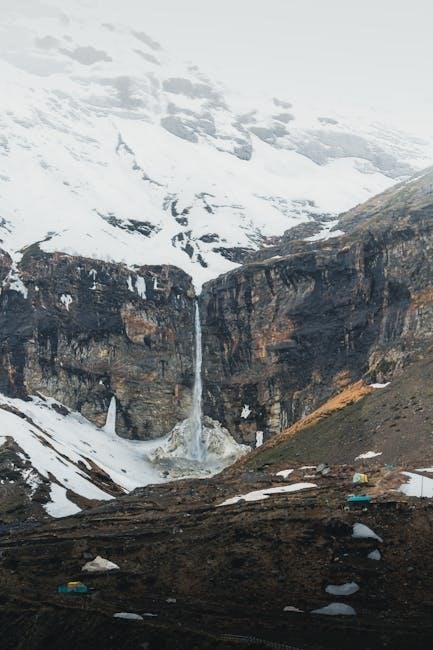
Conservation Efforts in Canyons
Conservation efforts focus on protecting canyon landscapes through sustainable tourism, community involvement, and research initiatives, such as the Wildlife Conservation Society’s historical expeditions and Navajo Nation’s eco-friendly lodge reopenings.
Protecting Canyon Landscapes
Protecting canyon landscapes involves preserving their natural beauty and ecological balance. Conservation efforts focus on preventing erosion, managing tourism impact, and safeguarding unique biodiversity. National parks and reserves play a crucial role by enforcing regulations and promoting sustainable practices. Education and community involvement are key to raising awareness about the importance of these natural wonders. By implementing strict environmental policies and encouraging eco-friendly tourism, we can ensure that canyons remain untouched for future generations to explore and appreciate.
Managing Tourism Impact
Managing tourism impact in canyons requires balancing visitor access with environmental and cultural preservation. Strategies include limiting daily visitor numbers, enforcing trail restrictions, and promoting eco-friendly practices. Guided tours, like those in Lynn Canyon Park, help educate visitors while minimizing ecological disruption. Conservation efforts, such as those by the Wildlife Conservation Society, emphasize sustainable tourism practices. Additionally, initiatives like reopening Marble Canyon Lodge with community involvement highlight the importance of integrating local stakeholders in tourism management. These measures ensure that canyons remain pristine for future generations while supporting local economies and cultural heritage.
Role of National Parks and Reserves
National parks and reserves play a vital role in protecting canyon landscapes, preserving biodiversity, and promoting sustainable tourism. They implement conservation efforts, such as habitat restoration and wildlife protection, ensuring the integrity of these natural wonders. Parks also provide educational programs, raising awareness about canyon ecosystems and cultural significance. By managing visitor access and regulating activities, they balance tourism with environmental preservation. Additionally, these protected areas support scientific research, aiding in the understanding and safeguarding of unique geological formations and endangered species. Their efforts foster a deeper appreciation for canyons, encouraging responsible exploration and long-term conservation.
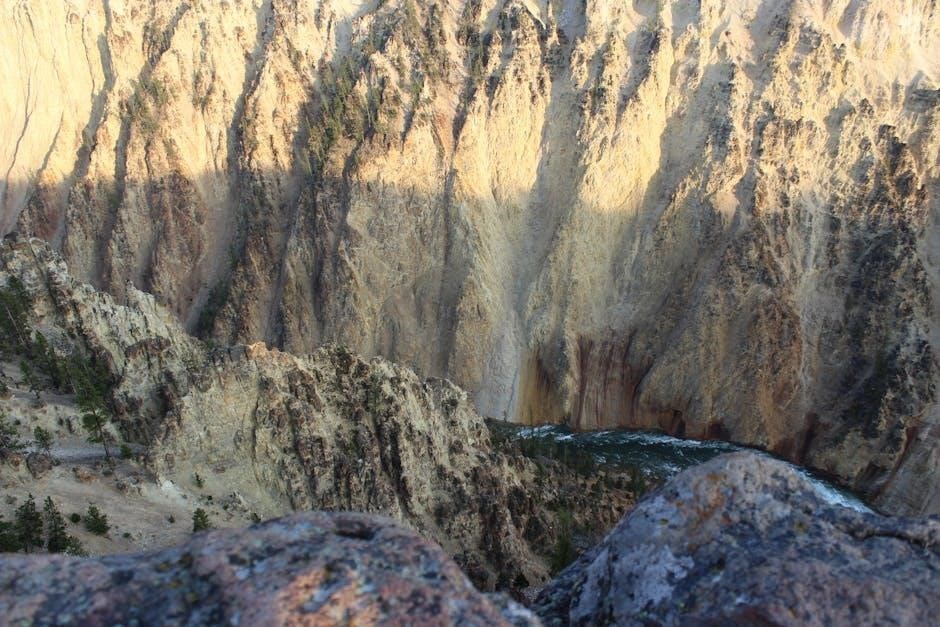
Cultural and Historical Significance
Canyons hold deep cultural and historical value, often serving as sacred sites for indigenous peoples and witnesses to ancient civilizations, blending natural beauty with human heritage.
Indigenous Peoples and Canyons
Indigenous peoples have deep cultural and spiritual connections to canyons, often considering them sacred landscapes. Many canyons, like Antelope Canyon, are managed by Native American tribes, such as the Navajo Nation, who emphasize preservation and sustainable tourism. These communities have lived in harmony with canyon ecosystems for centuries, relying on them for resources and spiritual guidance. Their traditional knowledge plays a vital role in conservation efforts, while their stories and art highlight the canyons’ cultural significance. Supporting indigenous-led initiatives helps protect these natural wonders and promotes cross-cultural understanding.

By respecting indigenous stewardship, we honor the canyons’ enduring legacy.
Historical Events in Canyon Regions
Canyons have witnessed significant historical events, shaping human and natural history. The 1925 Arcturus expedition explored canyon ecosystems, while Marble Canyon Lodge’s reopening highlighted Navajo Nation’s cultural revival. These regions often served as trade routes and spiritual sites for indigenous communities. Historical events in canyons reflect human adaptation and environmental interaction, offering insights into past civilizations and their connections to these natural wonders.
Spiritual and Religious Importance
Canyons hold profound spiritual and religious significance for many cultures, often viewed as sacred spaces. Their vast, awe-inspiring landscapes evoke feelings of humility and connection to the divine. For indigenous communities, canyons are ancestral homelands, hosting rituals and ceremonies. In some traditions, they are believed to be gateways to the spiritual realm. The serene beauty of canyons also makes them ideal for meditation and reflection, fostering a deep sense of inner peace. Their enduring presence reminds us of nature’s power and the importance of preserving these natural wonders for future generations to reverence and appreciate.
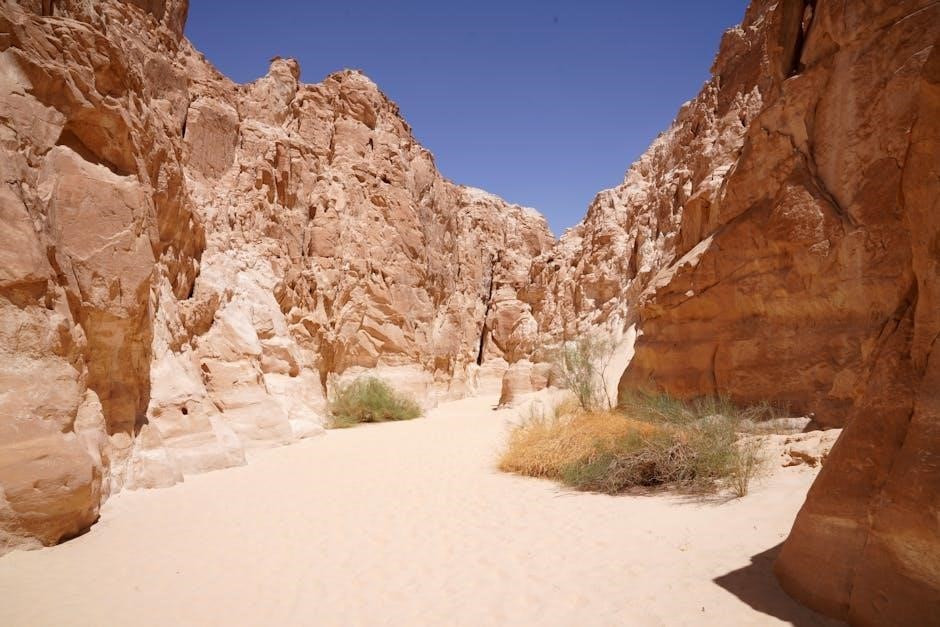
Adventure Activities in Canyons
Canyons offer thrilling adventures like hiking, rock climbing, and whitewater rafting, allowing explorers to immerse themselves in stunning landscapes and experience nature’s raw beauty up close.
Hiking and Trekking
Hiking and trekking are popular ways to explore canyons, offering immersive experiences with nature. Trails like those in Lynn Canyon Park provide stunning views and diverse terrain. Guided tours are recommended for safety and deeper insights. Essential gear includes sturdy footwear, water, and navigation tools. Hiking allows visitors to connect with unique ecosystems and geological wonders. Always respect trail markers and environmental guidelines to preserve these natural treasures for future explorers.
Rock Climbing and Rappelling
Rock climbing and rappelling are thrilling adventures in canyons, offering breathtaking views and physical challenges. Popular spots like Bryce Canyon and Zion attract climbers with unique rock formations. Proper equipment, including ropes, harnesses, and helmets, is essential for safety. Guided tours with experienced instructors are recommended for beginners. Rappelling down steep canyon walls provides an adrenaline rush, while climbing allows explorers to discover hidden vistas. These activities require strength, endurance, and mental focus. Always check weather conditions and canyon regulations to ensure a safe and enjoyable experience. Respect the environment to preserve these natural wonders for future generations.
Whitewater Rafting and Kayaking
Whitewater rafting and kayaking are thrilling ways to explore canyons, offering adrenaline-pumping adventures through rugged river rapids. These activities require proper gear, including helmets, life jackets, and sturdy boats. Beginners should start with calmer waters, while experienced enthusiasts can tackle challenging rapids. Scouting the river beforehand and understanding the difficulty levels is crucial for safety. Guided tours are highly recommended, especially for navigating unfamiliar terrains. The reopening of Marble Canyon Lodge highlights the growing interest in such adventures, providing access to stunning canyon landscapes. These water-based explorations offer unique perspectives on canyon beauty and geological wonders.
Camping in Canyon Areas
Camping in canyon areas offers a unique way to connect with nature, surrounded by dramatic landscapes and serene environments. Popular spots like Marble Canyon Lodge provide transformed amenities, blending comfort with adventure. Explorers can immerse themselves in the tranquility of canyon nights, stargazing under vast skies. Guided explorations, such as those in Lynn Canyon Park, offer educational insights into local ecosystems. Camping requires preparation, including proper gear and knowledge of local regulations. It’s a chance to disconnect from urban life and recharge amidst breathtaking geological wonders, creating unforgettable memories for outdoor enthusiasts.
Conclusion
Canyons are awe-inspiring natural wonders, offering breathtaking landscapes and rich geological history. Exploring these formations fosters a deeper connection with nature and encourages preservation for future generations.
Final Thoughts on Canyon Exploration
Exploring canyons is a humbling experience, offering a glimpse into nature’s grandeur and Earth’s history. These natural wonders inspire awe and curiosity, inviting adventurers to uncover their secrets. Whether hiking, photographing, or simply absorbing the beauty, canyons remind us of the importance of conservation and responsible tourism. As we venture into these landscapes, it’s crucial to respect their fragility and preserve them for future generations. Embrace the journey, capture memories, and leave a positive impact on these incredible environments.
Encouragement to Visit and Respect Canyons
Exploring canyons offers a chance to connect with nature’s grandeur and history. These natural wonders inspire awe and curiosity, providing opportunities for adventure and learning. Visiting canyons responsibly ensures their preservation for future generations. Remember to respect local ecosystems, follow guidelines, and minimize your impact. By doing so, you contribute to the conservation of these unique landscapes. Embrace the beauty of canyons while fostering a deeper appreciation for Earth’s natural heritage. Your thoughtful approach will help protect these incredible sites for years to come.